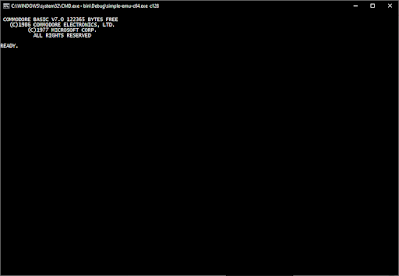One wonderful feature of the Commodore 128 was its compatibility with the Commodore 64. It was an evolution of the Commodore 64 and still supported all the software and hardware from before. For me it was a no-brainer to buy. 80 columns, plus new features, plus CP/M. Adding a mouse, GEOS 128, REU 512K, and 3.5" floppy, and I thought it was the best place to be this side of heaven.
There were multiple ways to go into Commodore 64 mode.
- Start with a Commodore 64 cartridge
- Boot/reset with the Commodore key held
- Commodore 128 boot disk that switched to Commodore 64 mode
- Switch MMU to Commodore 64 mode
- GO 64 command
PET 2001 2K to 64K supported
Vic-20 5K to 40K supported in hardware supported increments, not all available to BASIC64 RAM 3K to 64K supported not all available to BASIC
Commodore 16 and Plus/4 support 16K, 32K, or 64KCommodore 128 fixed at 128K (KERNAL does not do RAM test)
Limitations? Oh, sorry. This emulator is text only. No full screen editor. Doh! No screen pokes either (well not displayed). [Update 6/2021:] PETSCII and commodore graphics characters supported with third party font. Does support console history editor on Windows. Linux and MAC builds (you can build from my open source project) provide only simple line editing capability. Does provide accurate 6502/6510/8502 emulation, RAM banking, etc. according to the platform. So pop into the MONITOR on C128 or C16, Plus/4, or SUPERMON on other platforms to write and edit machine code. And because using console window, the text display size is not as limited, 88 columns for Vic-20 and 160 columns for C128.
 |
| Resizable text console - 132x50 text screen on Commodore 128 |
 |
| Bil Herd, Ted/C128 hardware design project lead (left) and Dave Van Wagner, geek (right) |







No comments:
Post a Comment